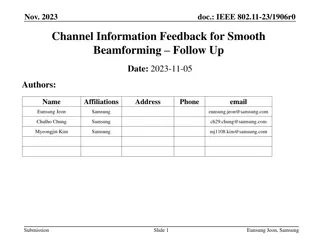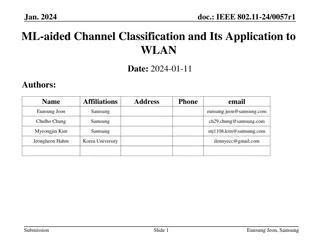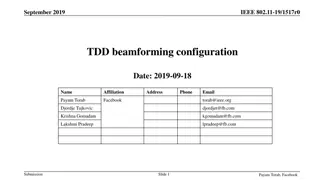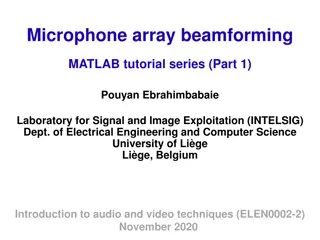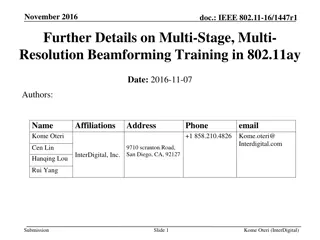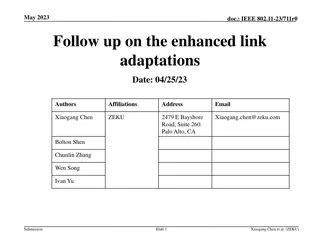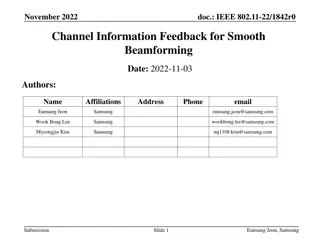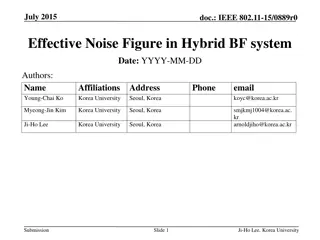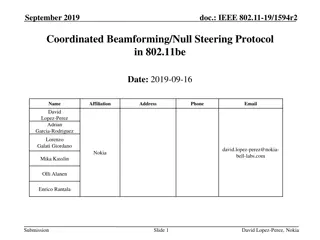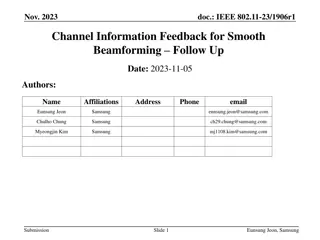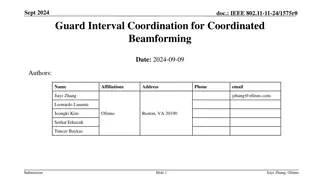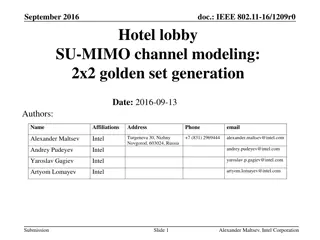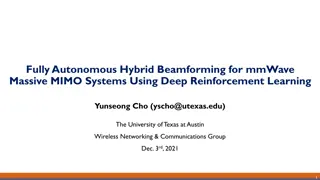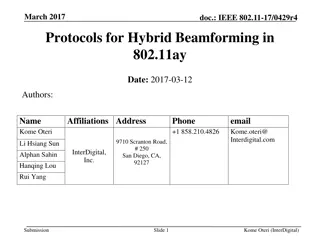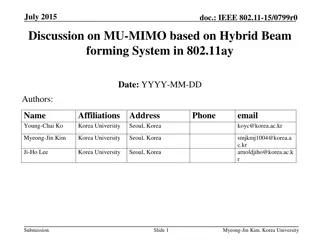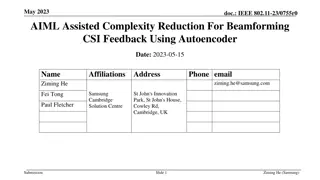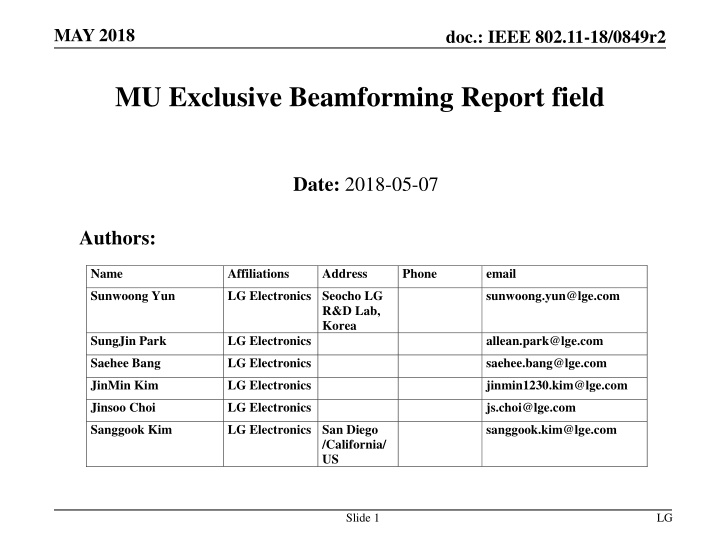
IEEE 802.11-18/0849r2 MU Exclusive Beamforming Report May 2018
Explore the detailed May 2018 report on MU Exclusive Beamforming in IEEE 802.11-18/0849r2, focusing on enhancing MU-MIMO performance through beamforming algorithms and channel selectivity analysis in 11ay compared to 11ac. Discover insights on per-tone SNR calculation, differential concepts, and proposed methods for improving MU-MIMO transmission in wireless communications.
Download Presentation

Please find below an Image/Link to download the presentation.
The content on the website is provided AS IS for your information and personal use only. It may not be sold, licensed, or shared on other websites without obtaining consent from the author. If you encounter any issues during the download, it is possible that the publisher has removed the file from their server.
You are allowed to download the files provided on this website for personal or commercial use, subject to the condition that they are used lawfully. All files are the property of their respective owners.
The content on the website is provided AS IS for your information and personal use only. It may not be sold, licensed, or shared on other websites without obtaining consent from the author.
E N D
Presentation Transcript
MAY 2018 doc.: IEEE 802.11-18/0849r2 MU Exclusive Beamforming Report field Date: 2018-05-07 Authors: Name Affiliations Address Phone email Sunwoong Yun LG Electronics Seocho LG sunwoong.yun@lge.com R&D Lab, Korea SungJin Park LG Electronics allean.park@lge.com Saehee Bang LG Electronics saehee.bang@lge.com JinMin Kim LG Electronics jinmin1230.kim@lge.com Jinsoo Choi LG Electronics js.choi@lge.com Sanggook Kim LG Electronics San Diego sanggook.kim@lge.com /California/ US Slide 1 LG
MAY 2018 doc.: IEEE 802.11-18/0849r2 Introduction(1/2) In 11ac, MU Exclusive Beamforming Report field is defined in addition to compressed beamforming report field to enhance MU- MIMO performance Unlike SU-MIMO where feedback is sufficient, MU-MIMO precoding algorithms can get benefit from knowledge of the transmit correlation VS2VH with more accurate S per subcarrier. However, in 11ay, the average SNR per stream within the Channel Measurement Feedback is only defined and there is no additional information for MU-MIMO Slide 2 LG
MAY 2018 doc.: IEEE 802.11-18/0849r2 Introduction(2/2) So, 11ay also need to define additional information for MU-MIMO transmission similar to 11ac In this presentation, we propose to add MU-Exclusive beamforming report field in the Digital BF feedback element for 11ay Slide 3 LG
MAY 2018 doc.: IEEE 802.11-18/0849r2 Observation Points(1/3) : Per-tone-SNR Calculation In 11ac, Delta SNR is used for MU Exclusive Beamforming Report where Vk,i is the ith column of the feedback beamforming matrix at subcarrier k, N is the noise plus interference power and is the average SNR of space- time stream i The difference at each per-tone-SNR relative to the average SNR per stream Average SNR has 0.5dB granularity, Delta-SNR has 1dB granularity Also, to reduce feedback overhead, 11ac reports Delta SNRs for tones spaced 2*Ng apart Slide 4 LG
MAY 2018 doc.: IEEE 802.11-18/0849r2 Observation Points(2/3) : 11ac channel vs 11ay channel 11ay channel has lower selectivity than 11ac Channel TGnD TGnD channel 11ay CR channel Average SNR :10.0052 Max SNR : 11.2592 min SNR : 8.6318 Variance : 0.4359 Average SNR :10.7311 Max SNR : 11.2826 min SNR : 10.0171 Variance : 0.0909 So, we can similarly introduce differential concept into 11ay Slide 5 LG
MAY 2018 doc.: IEEE 802.11-18/0849r2 Observation Points(3/3) : Issue on conventional method However, in 11ay, [1] shows that channel can have more frequency selectivity due to reflection Moreover, the system design should cover a various of channel environments So, we propose differential SNR method between adjacent tones spaced Ng apart not between average SNR and tones spaced 2*Ng apart in 11ac The range of feedback SNR value is increased Slide 6 LG
MAY 2018 doc.: IEEE 802.11-18/0849r2 Proposed Method : Differential SNR Differential SNR The relative difference of per-tone-SNR between adjacent Ng tones From -8dB to 7dB with 1dB granularity 2 2 ????,? ? ? ?? ?,? ? ?_????,?= min max ????? 10???10 10???10 , 8 ,7 For the first subcarrier in Ng tones 2 ??????(0)??????(0),? ? ?_????????(0),?= 10???10 Quantized to 8bits in the range -8 dB to 55.75 dB with 0.25 dB granularity. Same Ng value is used for MU Exclusive field not 2*Ng We can reuse tone index in compressed BF without additional definition Slide 7 LG
MAY 2018 doc.: IEEE 802.11-18/0849r2 Conclusion We propose MU Exclusive Beamforming to enhance MU-MIMO performance similar to 11ac Also, we propose differential-SNR method between adjacent tones spaced Ng apart to increase SNR range to feedback Slide 8 LG
MAY 2018 doc.: IEEE 802.11-18/0849r2 Straw Poll #1 Do you agree to accept the text in11-18/0850r1 -Draft text for MU Exclusive Beamforming Report field? Slide 9 LG
MAY 2018 doc.: IEEE 802.11-18/0849r2 References [1] 11-18-0401-00-00ay-reflection-measurements [2] 11-16-1388-00-00ay-implementation-of-channel-models-for-ieee-802- 11ay Slide 10 LG

